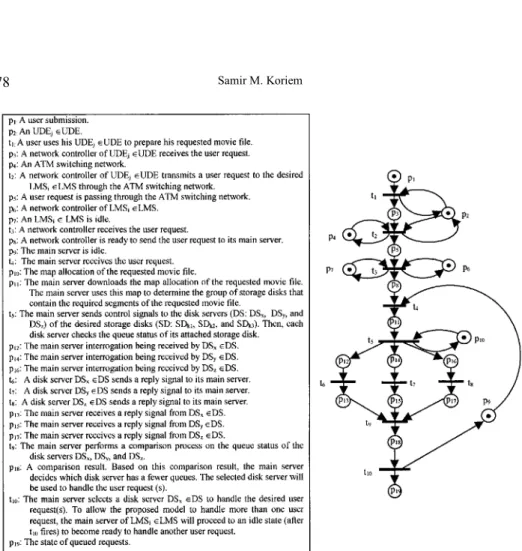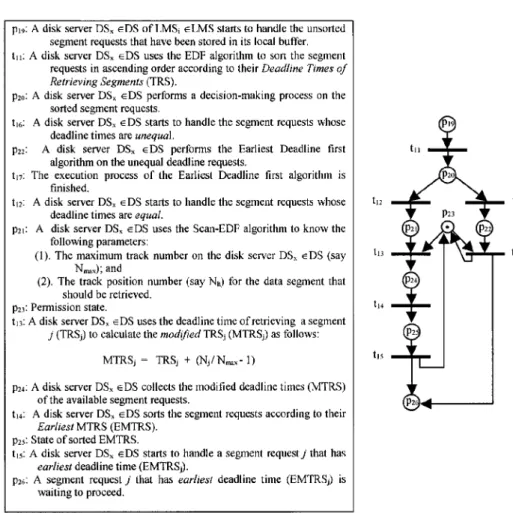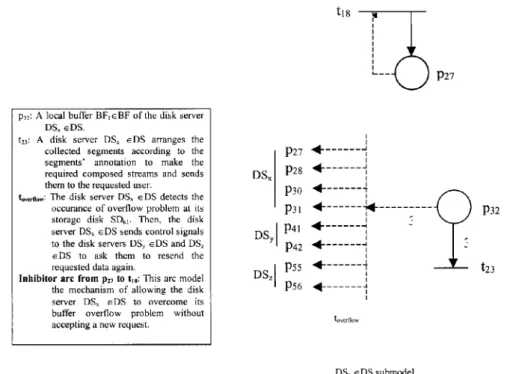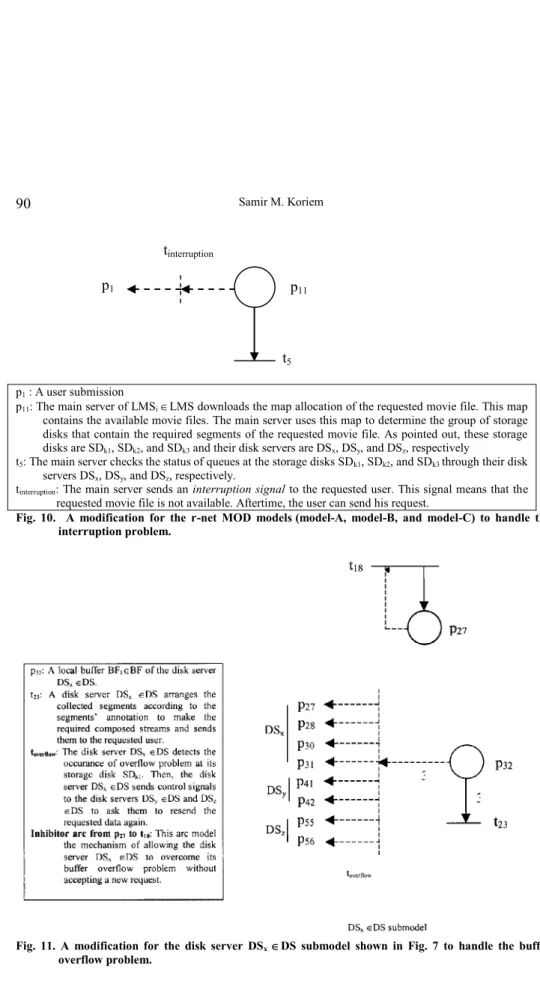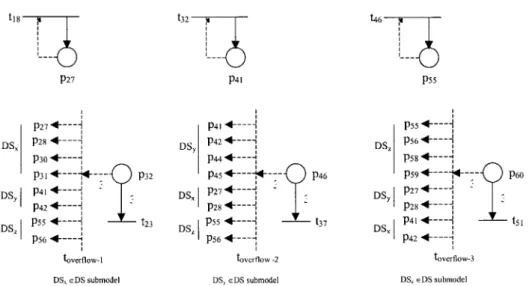DTPNs extend TPNs by assigning static delay intervals to the transitions and arcs of the net. How the disk scheduling algorithms in the R-net MOD models can be used to describe the real-time scheduling processes of the concurrent user requests. In this example, we illustrate the modeling mechanism of the R-net technique, as shown in Fig.
An illustration of the solution steps and verification processes of the R-net model shown in Fig.
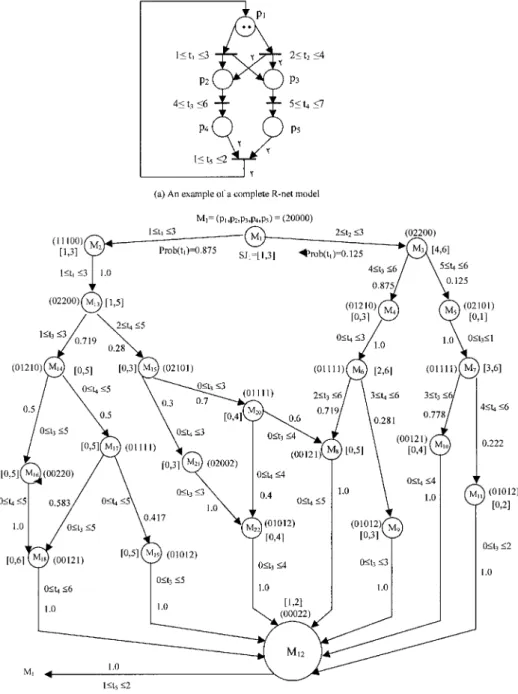
Solution technique for R-nets
It is interesting to note that the solution steps, firing rules and verification processes of the R-net technique are automated through our R-NET package [28]. The calculation processes of the steady-state probabilities of the derived Markov chain from the developed R-net model are automated through our R-NET package [28].
Mod Architecture
User display equipment (UDE)
Central multimedia server (CMS)
Local multimedia servers (LMSs)
- Storing process of the movie files
- Serving process of the user request
Each storage disk array (SDA: SD1, SD2, …, SDk) has the ability to store a subset of the total set of movie files. LMS serves the user request by retrieving the segments of the desired movie file and reassembling the data segments into contiguous blocks or streams to satisfy the multimedia request. To know the storage allocation locations of the segments of each movie file across the different storage disks of the desired array, the master server of each LMSi LMS builds an allocation map for each stored movie file in its disk array.
Then the main server uses the allocation map to schedule the deadline times of the requested movie files (TRM). This scheduling process can be done using one of the available disk scheduling algorithms. The following comparison illustrates the different parameters that have an effect on the deadline times of the requested movie file j (TRMj).
It indicates the time estimated by the LMSi LMS's disk servers (DS) to store the retrieved n segments of the requested movie file in their local buffers. It indicates the time estimated by the LMSi LMS main server to assemble all the fetched segments of the desired user request into composite streams. As a conclusion, each LMSi LMS starts serving the user request by collecting the desired segments of the requested movie file.
R-Net Model For A Simple Mod Architecture
Sub-model of the receiving mechanism of the main server
Each DSx DS disk server then accesses its storage disk to obtain the requested segment(s). Let's assume that there is a queue of requests for unselected segments on the DSx DS disk server of LMSi LMS. The DSx DS disk server uses the EDF algorithm to perform the following steps before serving any of them.
The DSx DS disk server starts arranging requests of unselected segments in ascending order according to their last schedule. In this example, the DSx DS uses the EDF policy to schedule segment requests as follows: SR4, SR5, SR3, SR1, and SR2. In this example, EDF uses the FIFO technique to handle SR4 segment requests.
In this example, the DSx DS uses the EDF technique to serve SR3, SR1, and SR2 segment requests. 5 describes the dynamic behavior of the DSx DS disk server when it applies the steps of the EDF algorithm to unselected segment requests. The scan-EDF scheduling algorithm execution sub-model from the DSx DS disk server.
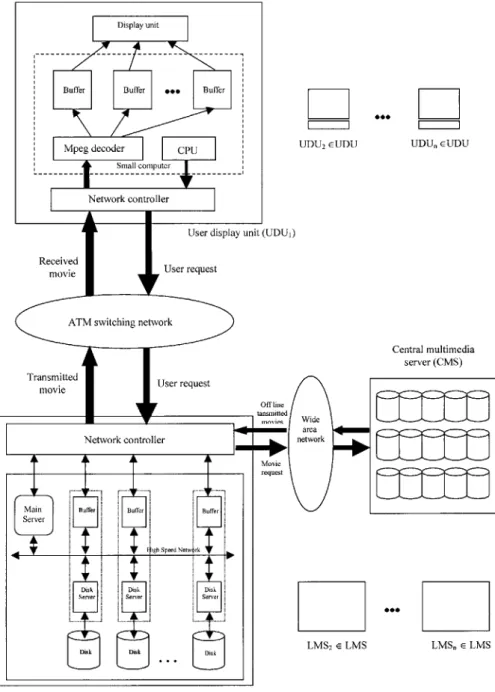
If some segment requests have the same deadline, then the EDF algorithm uses the FIFO technique to choose the one to be served before the others. When these requests are served with their modified deadline, the SR1, SR2, and SR3 segment requests are served in SR2, SR1, and SR3 scan order; SR4 will be served later. 6 describes the dynamic behavior of the DSx DS disk server when it executes the steps of the Scan-EDF algorithm on unsorted segment requests.
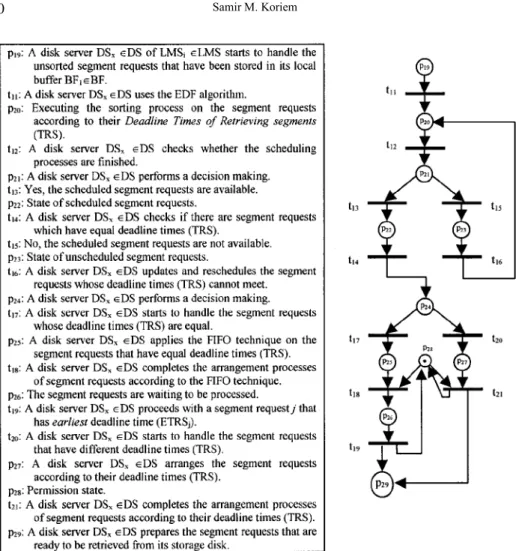
DS with their storage disks SDk1, SDk2 and SDk3 SD and their local buffers BF1, BF2 and BF3BF respectively. Thus, the main server selects the disk server DSx DS to handle the user request. Then, the main server allows the disk server DSx DS to retrieve the segments of the requested movie file from its storage disk SDk1 SD and store the retrieved segments in its local buffer BF1BF.
In parallel, the disk server DSx DS sends control signals to the disk servers DSy and DSz DS to retrieve the remaining parts of the desired segments from their storage disks SDk2 and SDk3SD and store them in their buffers BF2 and BF3BF. Then the disk server DSx DS collects and stores all the desired segments in its buffer BF1BF. UDEj UDE sends +ACK message or –ACK message to the main server of LMSi LMS.
The requested UDEjUDE user receives and displays composite streams of the requested movie file. 4, 6, 7, and 8 describe the R-net MOD model as it executes the Scan-EDF disk scheduling algorithm.
R-Net Model For An Exact Mod Architecture
Submodel I describes the transmission processes of the requested movie files from multiple users to multiple LMSs through the ATM switching network. The meanings of the places and transitions of the DSx DS model are the same as those of Fig. The meanings of the places and transitions of the DSy DS model are the same as those of Fig.
The meanings of the places and transitions of the DSz DS model are the same as those of figure. Submodel-III describes the dynamic behavior of the DSx, DSy, and DSz DS disk servers as they pull the required segments from storage. disks SDk1, SDk2 and SDk3 SD, respectively. The meanings of the DSx DS submodel places and transitions are the same as those of Fig.
The meaning of the places and transitions of the DSy DS sub-model are the same as those of Fig. the places and passages of this sub-model are the same as those of Fig.
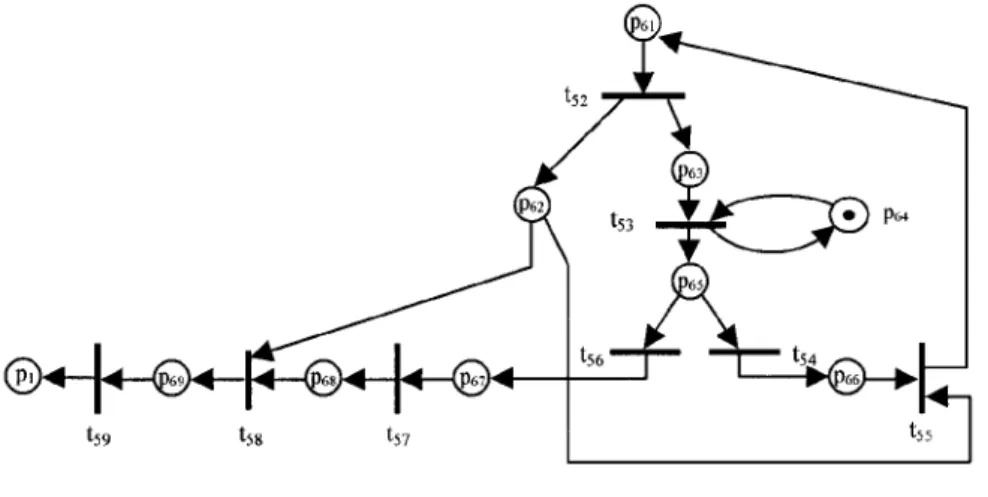
Performance Evaluation
Performance measures I. Quality of service (QoS)
Submodel-V describes the transmission processes of the composite streams of the requested movie file from the main server of LMSi LMS to the requested UDEj UDE through the ATM switching network. In our models, we assume that each disk server in the LMSi LMS has a finite buffer size. To include such an aspect in the developed R-net MOD models, we have included the disk server submodels shown in Fig.
Similarly, the submodels of the DSx, DSy, and DSz DS disk servers are shown in figure. According to the R-net technique (explained in Section 2), the probability of interrupt (or the probability of data loss) is associated with the transition. The hue burst (or transition to overflow) is determined dynamically in any state in which this transition can fire. The concept of the RRT is explained mathematically via the TRMj time shown in Equation 4.
ASJ1 is the average residence time of the initial state S1; S1 is the steady state probability of the initial state S1;. S1 is the initial state of model-A, model-B or model-C when a location p1 contains one (or more) token(s). The master server uses this map to determine the group of storage disks that contain the required segments of the requested movie file.
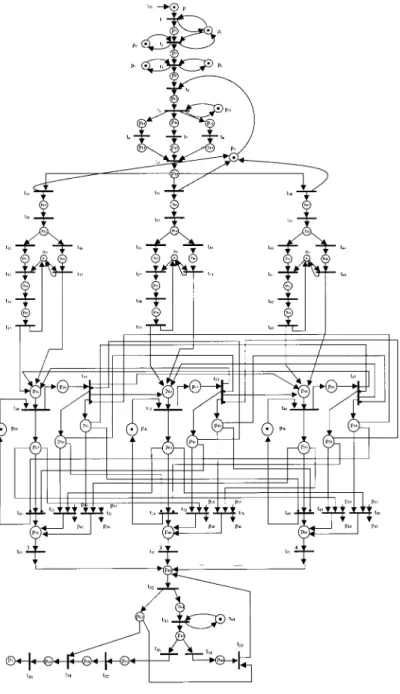
Disk scheduling algorithm time (DSAT)
Then the output of places p26, p40 and p54 must be connected to a transition tconnect and the output of transition tconnect to a place p18.
Actual retrieval time (ART)
Performance analysis
Moreover, the simulation results of the disk planning algorithms presented in [16] are obtained in a few hundred milliseconds, just like our performance results. For example, in [16], the simulation result of the Scan-EDF algorithm for six multimedia requests is approximately 800 msec. The results of the DSAT performance measurement (msec). shown in Figure 4) (submodel-II in model-A).
7 describes the dynamic behavior of the DSx DS disk server when it receives the requested movie file. Such disk server performs retrieval processes of requested movie files in a sequential manner. 9 depicts the dynamic behavior of the three disk servers DSx, DSy and DSz DS when they work together in a parallel fashion to retrieve the requested movie files.
This difference is due to the waiting time spent in the master LMSi LMS buffer until one of the three disk servers DSx, DSy and DSz DS becomes free. ART performance measurement results (msec) NMR Retrieval-submodel. shown in Figure 6) (submodel-III in Model A or B). Thus, from the results of the QoS performance, we can decide on the optimal number of multimedia requests, which prevents degradation of the MOD system performance.

Conclusions
The type of disk scheduling algorithm that can be used in the MOD system affects the RRT performance results. The request response time increases by very few msec when the number of users increases. Thus, the delay a user experiences in watching a movie is not greatly affected by the number of users on the system.
In addition, the QoS results provide insight into the maximum workload (multimedia requests) that the MOD system can support. This comparison gives us more confidence that the performance results obtained from the developed R-net MOD models are realistic. This realistic model can be extended to describe the actual dynamic behavior of n disk servers.
We have used this representation to analyze the effect of scheduling algorithms on the quality of service of the MOD system. To facilitate the analysis of the MOD service system R-net models, we have constructed them based on a modular technique. Timing Constraint Petri Nets and their application to planning analysis of real-time system specifications”.
طﺎﺳوﻷا ةدﺪﻌﺘﻤﻟا ﺔﻤﻈﻧﻷا ﺔﺳارد
ﻢﻳرﻮﻛ دﻮﻤﺤﻣ ﺮﻴﻤﺳ
ﺚﺤﺒﻟا ﺺﺨﻠﻣﻲﻠﻋ يﻮﺘﲢ تﺎﻧﺎﻴﺑ لوﺎﻨﺗ طﺎﺳوﻻا ةدﺪﻌﺘﳌاا ﺔﻤﻈﻧﻻا لﻼﺧ ﻢﺘﻳ
ﺔﻴﺋﺮﻣ رﻮﺻو صﻮﺼﻧ
كﺎﻨﻫ .ﺔﻴﻧﻮﻳﺰﻔﻴﻠﺘﻟا ﺞﻣاﱪﻟا و مﻼﻓﻷا ﰲ ﺎﻫﺪﻫﺎﺸﻧ ﱵﻟا تﺎﻣﻮﻠﻌﳌا ﻞﺜﲤ ﱵﻟا ﻲﻫ تﺎﻧﺎﻴﺒﻟا ةﺬﻫ ،ﺔﻴﺗﻮﺻ و ﺔﺟﺬﳕ ،ﺮﻳﻮﻄﺗ ﺔﻴﻠﻤﻋ اﺬﻛو تﻮﺼﻟا ﻊﻣ ةرﻮﺼﻟا ﻦﻣاﺰﺗ ﺔﻴﻠﻤﻋ ﻲﻫو ءﺎﻤﻠﻌﻟا ﻞﺒﻗ ﻦﻣ ﺎﻬﺜﲝ ﻢﺘﻳ ﺔﻠﻜﺸﻣ
را" ـﺑ فﺮﻌﻳ ﻚﻴﻨﻜﺗ ماﺪﺨﺘﺳﺎﺑ ﻂﺴﺒﻣ جذﻮﳕ ﻞﻤﻋ ﻖﻳﺮﻃ ﻦﻋ-
ﻞﺜﳝ ﻲﻘﻴﻘﺣ ﻞﻣﺎﻛ جذﻮﳕ ﺬﻴﻔﻨﺗ ﰎ ﰒ ، طﺎﺳوﻻا ةدﺪﻌﺘﳌا ﺔﻤﻈﻧﻼﻟ جذﻮﳕ ﻞﻤﻋ ﺔﻴﻔﻴﻛ ﻢﻬﻓ ﻲﻠﻋ ﲔﺜﺣﺎﺒﻟا ﺼﺗﻻا ثوﺪﳊ ﻲﻘﻴﻘﳊا ﺖﻗﻮﻟا ﰲ ﻲﻜﻴﻣﺎﻨﻳﺪﻟا كﻮﻠﺴﻟا
